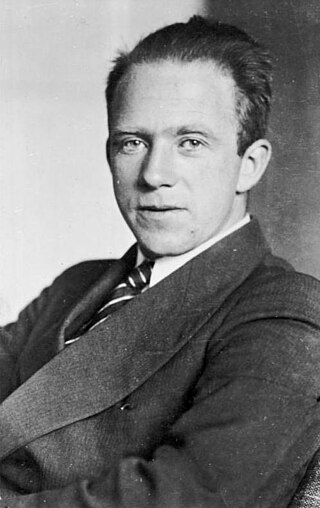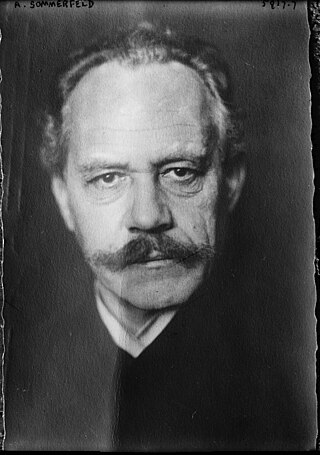
Werner Karl Heisenberg was a German theoretical physicist, one of the main pioneers of the theory of quantum mechanics and a principal scientist in the Nazi nuclear weapons program during World War II. He published his Umdeutung paper in 1925, a major reinterpretation of old quantum theory. In the subsequent series of papers with Max Born and Pascual Jordan, during the same year, his matrix formulation of quantum mechanics was substantially elaborated. He is known for the uncertainty principle, which he published in 1927. Heisenberg was awarded the 1932 Nobel Prize in Physics "for the creation of quantum mechanics".
In physics, a correspondence principle is any one of several premises or assertions about the relationship between classical and quantum mechanics. The physicist Niels Bohr coined the term in 1920 during the early development of quantum theory; he used it to explain how quantized classical orbitals connect to quantum radiation. Modern sources often use the term for the idea that the behavior of systems described by quantum theory reproduces classical physics in the limit of large quantum numbers: for large orbits and for large energies, quantum calculations must agree with classical calculations. A "generalized" correspondence principle refers to the requirement for a broad set of connections between any old and new theory.

Max Born was a German-British theoretical physicist who was instrumental in the development of quantum mechanics. He also made contributions to solid-state physics and optics and supervised the work of a number of notable physicists in the 1920s and 1930s. Born was awarded the 1954 Nobel Prize in Physics for his "fundamental research in quantum mechanics, especially in the statistical interpretation of the wave function".
In physics, a hidden-variable theory is a deterministic physical model which seeks to explain the probabilistic nature of quantum mechanics by introducing additional variables.

Arnold Johannes Wilhelm Sommerfeld was a German theoretical physicist who pioneered developments in atomic and quantum physics, and also educated and mentored many students for the new era of theoretical physics. He served as doctoral supervisor and postdoc supervisor to seven Nobel Prize winners and supervised at least 30 other famous physicists and chemists. Only J. J. Thomson's record of mentorship offers a comparable list of high-achieving students.

Carl Friedrich Freiherr von Weizsäcker was a German physicist and philosopher. He was the longest-living member of the team which performed nuclear research in Nazi Germany during the Second World War, under Werner Heisenberg's leadership. There is ongoing debate as to whether or not he and the other members of the team actively and willingly pursued the development of a nuclear bomb for Germany during this time.

The Gottfried Wilhelm Leibniz Prize, or Leibniz Prize, is awarded by the German Research Foundation to "exceptional scientists and academics for their outstanding achievements in the field of research". Since 1986, up to ten prizes have been awarded annually to individuals or research groups working at a research institution in Germany or at a German research institution abroad. It is considered the most important research award in Germany.
In quantum field theory and statistical mechanics, the Hohenberg–Mermin–Wagner theorem or Mermin–Wagner theorem states that continuous symmetries cannot be spontaneously broken at finite temperature in systems with sufficiently short-range interactions in dimensions d ≤ 2. Intuitively, this theorem implies that long-range fluctuations can be created with little energy cost, and since they increase the entropy, they are favored.
Erich Schumann was a German physicist who specialized in acoustics and explosives, and had a penchant for music. He was a general officer in the army and a professor at the University of Berlin and the Technische Hochschule Berlin. When Adolf Hitler came to power he joined the Nazi Party. During World War II, his positions in the Army Ordnance Office and the Army High Command made him one of the most powerful and influential physicists in Germany. He ran the German nuclear energy program from 1939 to 1942, when the army relinquished control to the Reich Research Council. His role in the project was obfuscated after the war by the German physics community's defense of its conduct during the war. The publication of his book on the military's role in the project was not allowed by the British occupation authorities. He was director of the Helmholtz Institute of Sound Psychology and Medical Acoustics.
Wilhelm Lenz was a German physicist, most notable for his invention of the Ising model, and for his application of the Laplace–Runge–Lenz vector to the old quantum mechanical treatment of hydrogen-like atoms.
The history of quantum mechanics is a fundamental part of the history of modern physics. The major chapters of this history begin with the emergence of quantum ideas to explain individual phenomena—blackbody radiation, the photoelectric effect, solar emission spectra—an era called the Old or Older quantum theories. Building on the technology developed in classical mechanics, the invention of wave mechanics by Erwin Schrödinger and expansion by many others triggers the "modern" era beginning around 1925. Paul Dirac's relativistic quantum theory work lead him to explore quantum theories of radiation, culminating in quantum electrodynamics, the first quantum field theory. The history of quantum mechanics continues in the history of quantum field theory. The history of quantum chemistry, theoretical basis of chemical structure, reactivity, and bonding, interlaces with the events discussed in this article.

Hermann Haken was a German physicist and professor emeritus in theoretical physics at the University of Stuttgart. He is known as the founder of synergetics and one of the "fathers" of quantum-mechanical laser theory. He is a cousin of the mathematician Wolfgang Haken, who proved the Four color theorem. He was a nephew of Werner Haken, a doctoral student of Max Planck.

Georg Robert Döpel, best known as Robert Döpel, was a German nuclear physicist and a professor of physics at the Technical University of Ilmenau in Germany.
Reinhard Oehme was a German-American physicist known for the discovery of C non-conservation in the presence of P (parity) violation, the formulation and proof of hadron dispersion relations, the "Edge of the Wedge Theorem" in the function theory of several complex variables, the Goldberger-Miyazawa-Oehme sum rule, reduction of quantum field theories, Oehme-Zimmermann superconvergence relations for gauge field correlation functions, and many other contributions.

Markus Eduard Fierz was a Swiss physicist, particularly remembered for his formulation of spin–statistics theorem, and for his contributions to the development of quantum theory, particle physics, and statistical mechanics. He was awarded the Max Planck Medal in 1979 and the Albert Einstein Medal in 1989 for all his work.
Robert Graham is a German theoretical physicist.
Pierre Hohenberg was a French-American theoretical physicist, who worked primarily on statistical mechanics.

Werner Nahm is a German theoretical physicist. He has made contributions to mathematical physics and fundamental theoretical physics.

Siegfried Grossmann is a German theoretical physicist who has been awarded the Max Planck Medal, the major prize for achievements in theoretical physics.
Helmut Rechenberg was a German physicist and science historian.










